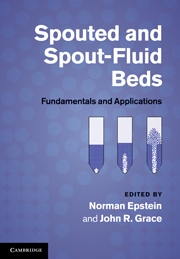Book contents
- Frontmatter
- Contents
- Contributors
- Preface
- Common nomenclature
- 1 Introduction
- 2 Initiation of spouting
- 3 Empirical and analytical hydrodynamics
- 4 Computational fluid dynamic modeling of spouted beds
- 5 Conical spouted beds
- 6 Hydrodynamics of spout-fluid beds
- 7 Spouted and spout-fluid beds with draft tubes
- 8 Particle mixing and segregation
- 9 Heat and mass transfer
- 10 Powder–particle spouted beds
- 11 Drying of particulate solids
- 12 Drying of solutions, slurries, and pastes
- 13 Granulation and particle coating
- 14 The Wurster coater
- 15 Gasification, pyrolysis, and combustion
- 16 Spouted bed electrochemical reactors
- 17 Scaleup, slot-rectangular, and multiple spouting
- 18 Mechanical spouting
- 19 Catalytic reactors and their modeling
- 20 Liquid and liquid–gas spouting of solids
- Index
- References
14 - The Wurster coater
Published online by Cambridge University Press: 04 February 2011
- Frontmatter
- Contents
- Contributors
- Preface
- Common nomenclature
- 1 Introduction
- 2 Initiation of spouting
- 3 Empirical and analytical hydrodynamics
- 4 Computational fluid dynamic modeling of spouted beds
- 5 Conical spouted beds
- 6 Hydrodynamics of spout-fluid beds
- 7 Spouted and spout-fluid beds with draft tubes
- 8 Particle mixing and segregation
- 9 Heat and mass transfer
- 10 Powder–particle spouted beds
- 11 Drying of particulate solids
- 12 Drying of solutions, slurries, and pastes
- 13 Granulation and particle coating
- 14 The Wurster coater
- 15 Gasification, pyrolysis, and combustion
- 16 Spouted bed electrochemical reactors
- 17 Scaleup, slot-rectangular, and multiple spouting
- 18 Mechanical spouting
- 19 Catalytic reactors and their modeling
- 20 Liquid and liquid–gas spouting of solids
- Index
- References
Summary
Introduction: particle coating techniques
The Wurster coater is a special variant of a fluidized or spouted bed (Figure 14.1) that resembles a spouted bed in being of conical-cylindrical construction, but normally has a gas distributor at its base, through which an upfacing spray nozzle projects. This nozzle is usually of the two-fluid type and is used to introduce a coating material – usually a solution, but sometimes a suspension or melt. It is customary to install a draft tube into the column, so particles are constrained to circulate upward inside the draft tube and downward in the annulus surrounding the draft tube. In this respect, Wurster coaters have similarities to spout-fluid beds containing draft tubes. Their main use is for coating pharmaceutical tablets and pellets, for which this is one of the most common methods.
Within the pharmaceutical industry, particulate materials are coated for a number of reasons: to produce controlled release dosage forms, to mask unpleasant tastes, to protect ingredients within the tablet/pellet from the environment (light, moisture, air, or undesirable pH), for aesthetic appeal, and to protect the consumer from toxic compounds that may cause gastric distress or nausea.
In industrial practice, particle coating is accomplished using several types of equipment, most notably rotating drum (or perforated pan) and fluidized bed coaters. (Fluidized beds are also used to agglomerate particles, but agglomeration is undesirable in coaters, which are therefore designed to minimize it.)
- Type
- Chapter
- Information
- Spouted and Spout-Fluid BedsFundamentals and Applications, pp. 238 - 249Publisher: Cambridge University PressPrint publication year: 2010



